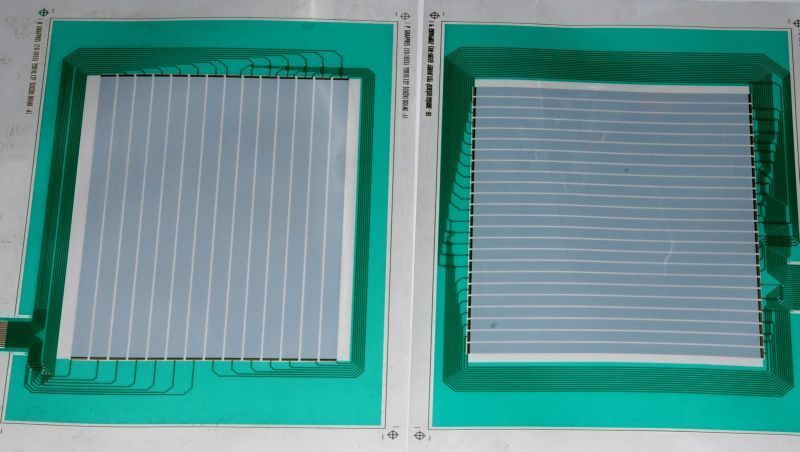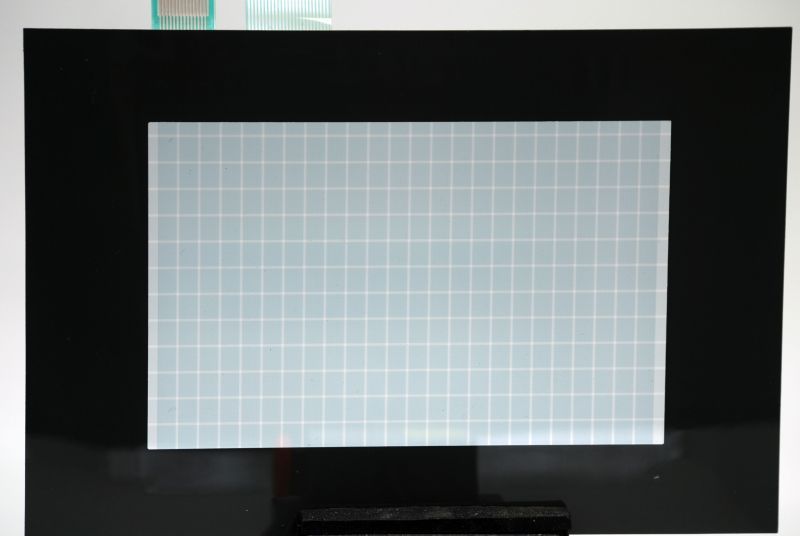







Transparent touch panels for short production runsA technological process, in which most of the panels are being produced, is unprofitable for short production runs. One of the most important elements of this process is first sputtering of indium tin oxide in vacuum and than etching using earlier prepared masks. In this way transparent electrodes come into being and it is possible to read signal that helps defining touch place of screen. For sale are available touch panels integrated with screens and proper interfaces. The wide range and low price of these products, that are mostly Far Eastern, cause that independent installation of panel on display is viable only under special conditions. It makes sense mainly when we have to do with the equipments of untypical shape or of non-standard deployment of touch points on the screen.
However, there is a different technology, that is suitable for making any transparent touch panels for untypical projects. It enables to construct transparent matrix membrane keyboards and buttons placed anywhere on screen or panels of unconventional shape and of almost any dimensions. The most important is the fact that it allows manufacturing products of this sort at low price already for short production runs.
This technology is based on printing of transparent electrode by means of industrial ink printers (Ink jet printers). Thanks to the fact that they are computer guided, the production cost of single panel or membrane keyboard is reduced to dealing with electronic project and using materials such as foil and proper inks. There is no need of making model masks. This project is stored in computer memory and realized by printer directly on foil. A secret of this technology conceals in special prepared polymer ink, which is transparent and conductive. It can be put on foil, glass, plastic or different surface.
The method of electrode overprinting is developed by specialists from QWERTY Sp. z o.o. company in Lodz, which is well-known supplier of membrane keyboards for electronic and electric devices made to order. This is the only manufacturer in Europe and one of the few who put this technology into practice on an industrial scale. To print electrodes this company makes use of self-modified printers and plotters. It is worth mentioning that the composition of ink was developed by employees of this company and it’s a trade secret.
This technology enables to produce different kinds of touch panels by overprinting. Nowadays the most popular are transparent matrix membrane keyboards, which consist of two foil layers. Inside they are overprinted by longitudinal, perpendicularly arranged, conductive electrodes (photo 1 and 2). Between foils there are small distance elements, which are applied by screen printing. Their deployment is adapted to the circuit and distance between buttons. On each of the foils for transparent electrodes are added outputs overprinted by conductive silver varnish. Traditionally they are printed in separate technological process, but they can be also made by ink printer, what reduces the number of separate production stages. It requires an additional printer mileage for each of two foils and proper ink. This method enables to make additional areas on the same grounds next to the same screen, which can be used for example for forming supplementary membrane functional buttons.
The same technology enables to make classical, analogue, resistive panels, in which we can read indicated position not by matrix scanning, but using proper electronic systems. Furthermore we can make capacitive touch panels by overprinting electrodes on glass plates, which are considerably resistant to destruction than those made of foil.
Printing touch screens has several limits, but this are the same factors, which make difficult to construct traditional panels with ITO electrodes. A resistivity of conductive ink is not zero. It is a reason why a proper manufacturing of well conductive electrode requires limited length or appropriate width and thickness. The ink is also not perfectly transparent, so it is impossible to make very long and narrow connections because they would have to be so thick that they would darken the view projected on the screen. Furthermore, distance between electrodes will not stand out if the electrodes will be overprinted by non-conductive ink, whose colour is identical to the electrode colour.
When the application requires a high touch resolution, instead of matrix we overprint the classical resistive touch panel. The operation precision depends on parameters of used electronic controller.
Since introduction of the new technology, QWERTY company made with it a lot of different touch panels. Mostly they are ordered as spare parts for devises, in which touch panel is necessary for their operation and is not replaceable with finished element available from distributors or in authorised services or this is too expensive.
A good example is a reconstruction commission of glass matrix touch screen, which was used in CAT scanner. The employees of this company specify the output system of panel, measure its dimensions and prepare the replacements made of plastic plates, which are much more resistant to breaking than glass. The production costs of such screen are lower than the purchase costs of a new screen in authorized service.
 Photo 1. Two layers, which after connection build a hermetic matrix touch panel. The photo was intentionally so taken that we can see overprinted transparent conductive ink. In reality it is poorly visible.
 Photo 2.
The matrix panel after connection of two foil layers. After application on display the panel is practically transparent. The drivers for touch panels do for example the EiE company. |
|